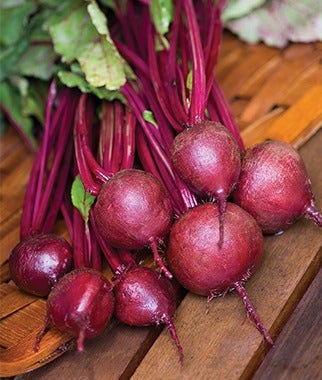We use cookies to give you the best experience on our website. These cookies are completely safe and secure and will never contain any sensitive information. Please read our Privacy Policy. By clicking "Ok" or clicking on any other content, you agree that cookies can be placed.
Focus On: Growing Fall Beets
Can I grow Beets?
Beets are extremely easy to grow, and respond very favorably to the cooling conditions of late summer into fall. Variations of daytime and nighttime temperatures provide the perfect conditions for growth. Beets are heavy water users due to the rapid formation of the edible root. To keep the soil consistently moist, put a 1-2'' layer of compost or mulch over the row. Because beets are very shallow-rooted, cultivation around the plants with a tool should be minimal; if weeds initiate, it's best to pull them by hand. Grow a lot of beets so they can be enjoyed from '' baby '' size to full maturity.
What is the best method to grow: Direct sown from seed or from seed started transplants?
Direct sown is the preferred method. Transplants can be quite challenging due to the rapid
formation of the root, and transplanting from a seed-starting tray to the garden has a very
small window for success. Direct sowing is very easy, since you want to have a very full row of
beets and thin as the seedlings germinate. Most seed packets of beets will contain from 200 to
350 seeds per pack, and this will allow for multiple sowings.
Do not depend on one sowing. The more often you sow (every 10 days), the more diversity you
will have in beet size and flavors. When you cover your seeds, use a mixture of _ garden soil
with _ peat moss or compost fines. The organic matter in peat and compost increases germination
percentage.
How to Grow/Growing Tips
Beets are a root crop, and your fertilizer should be light on nitrogen and more focused on
phosphorus and potassium (potash). An ideal ratio would be 1-2-2 with 5-10-10 being ideal
according to label instructions. Ten pounds per 100 square feet would be a safe application.
Your pH for beets is very important. Never allow pH to get below 6.0 or above 7.5. Adding 25
pounds of lime to 100 square feet of garden will assist in keeping a good pH range. If you have
experienced stunted, small beets in the past, you need to raise your pH (add lime). Beets love
a deep, rich soil, and while fertilizer will provide the needed nutrition for growth, add as
much organic matter as possible as a top dressing to keep a steady flow of nutrients to the
root. Organic matter will also improve your soil tithe; soils will not compact around the beet
root.
Direct sow into a _ '' deep trench in rows that can vary from 12-18'' apart, depending on your
growing systems (cultivation, irrigation). You are going to thin the seedlings at various
times: First, thin to 1'' apart, and then, as seedlings grow, finally thin to 3'' apart. As you
thin, these tasty greens are exceptional in salads and add a unique flavor.
Beets need to grow uninterrupted, and adequate watering is most important; never allow the
beets to dry out. Water the beets deeply so the roots seek the water in the soil. Beets respond
well if you grow them in a raised bed.
Harvesting Tips & Storage
Harvest and enjoy beets from their tasty baby stage through full maturity. Full harvest will
begin approximately 45 days from sowing. When beets stay in the garden too long (over 2'' in
size), they will become somewhat stringy and tough, and this is related to how well they are
being grown. Proper moisture in the garden is the key to good health. When you harvest, leave
the fibrous root that is attached to the bulb intact to prevent the beets from bleeding. If you
are growing the beets for their greens, the ideal tender size for harvest would be around
5''.
Beets can store nicely in a refrigerator for up to a month, and they can be frozen, too. Beets
(whole) are easy to pickle and jar for consumption all winter. When cooking, do not peel or
slice; boil beets whole. Our best experience is to cook beets by roasting; they cook in their
own juices, which increase the flavor.
Want to know more?
Due to their old-fashioned flavor, beets are now found in the best gourmet restaurants. They are also popular for their coloring, which adds beauty to the plate, and as a natural sweet dish to complement meat, seafood and starch. Culinary uses include pickling, raw (grated in salads or in slaw), puree, roasted or in bread recipes that call for fruit.When you consume both the greens and root, you are addressing your daily needs of calcium, iron and fiber. The greens are loaded with beta-carotene, a known cancer preventer. When cooking green or yellow vegetables, add a sliced beet to provide a food coloring to beautify your plate, as well as a natural sweetener. Any time you grill, wrap beets in aluminum foil and cook them for 10-12 minutes for exceptional complements to your main course.

